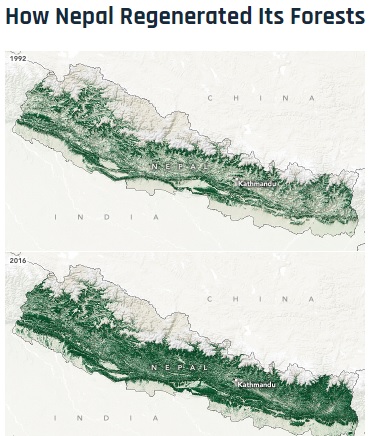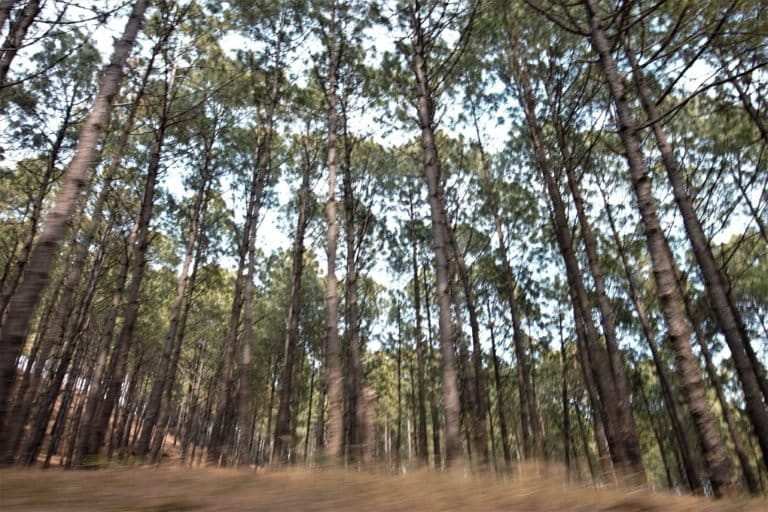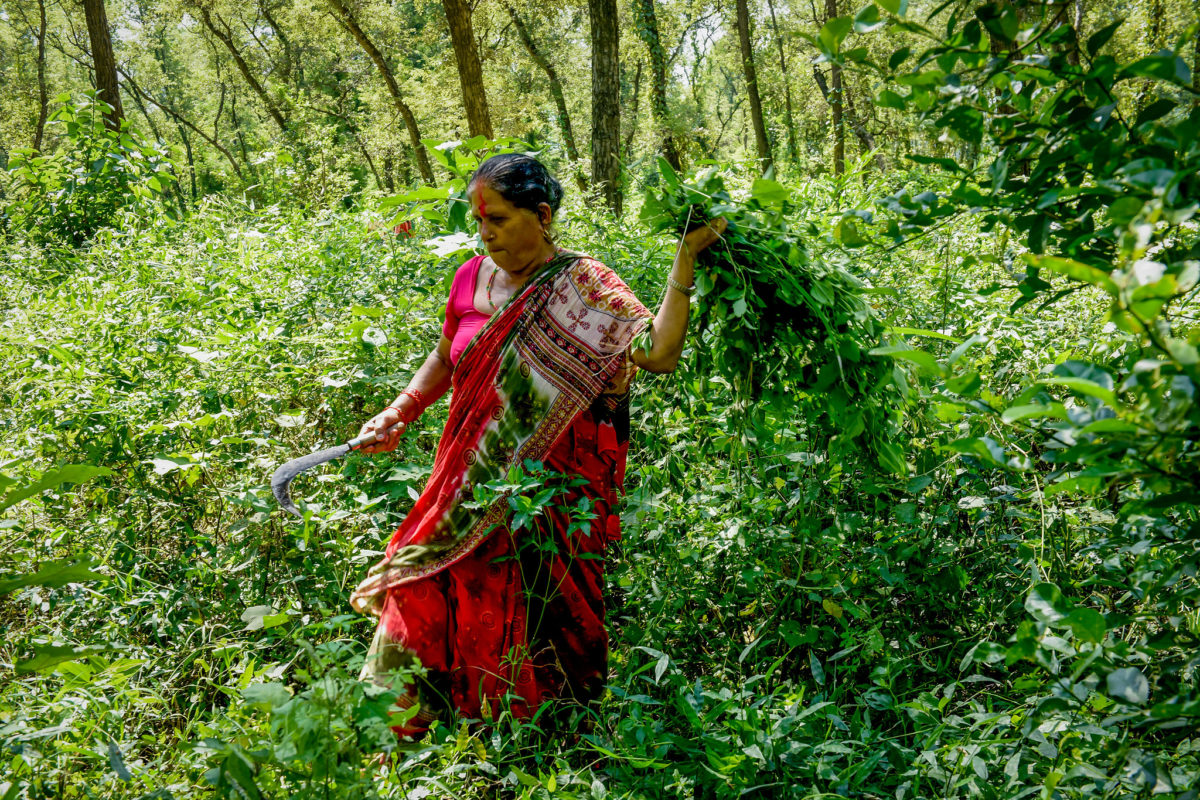- Nepal increased its forest cover from 26% to 45% in two-and-a-half-decades, but the success has translated into a limited win for biodiversity conservation, experts say.
- The reforestation gains came largely from the country’s community forestry program, which encourages communities to grow, manage and harvest their own forest resources.
- As such, the program’s focus has been an economic one, with many of the newly forested areas consisting of pine monocultures that are ideal for providing wood but make for poor wildlife habitat.
- Experts say there needs to be a greater emphasis on wildlife management in the community forestry program to address growing issues such as human-wildlife conflict and the spread of “green deserts” devoid of biodiversity.
KATHMANDU — When NASA’s Earth Observatory published a post on its website earlier this year describing how Nepal had regenerated its forests between 1992 and 2016, it received a lot of attention.
During this two-and-a-half-decade period, according to the “Image of the Day” post, the country’s forest cover increased from 26% to 45%, thanks to the implementation of community-prepared management plans.
But amid the euphoria, conservationists are growingly concerned that the management plans of most of the 22,000 community-forest user groups, collectively managing around one-third of the country’s forests, don’t adequately address issues related to the conservation of precious wild flora and fauna.

“In Nepal, we see that our forestry policy is geared towards the objectives of growing forest cover and earning money by selling timber and other forest resources,” says Kedar Baral, a divisional officer for the forest department in Kaski district, in the country’s central Gandaki province.
“Community forests provide habitat to key species of apex predators such as tigers and leopards as well as ungulates that they feed on,” Baral tells Mongabay.
The community-prepared management plans only go as far as making an inventory of the plants and wildlife found in a given forest area, says Dil Raj Khanal, a natural resources lawyer who advises the Federation of Community Forest User Network (Fecofun).
“That doesn’t help a lot in terms of biodiversity conservation,” Khanal tells Mongabay.
Under the community forestry scheme pioneered by Nepal in the 1970s, communities manage their forests for their own use and benefits based on an operational plan approved by the divisional forest officer, a representative of the provincial government. Once the plan is approved, community members are allowed to collect wood up to a limit prescribed by the government based on the availability of wood and the prevailing conditions of the forest.
This doesn’t address the needs of wildlife, Baral says.
“For example, herbivores such as deer require water holes in the forest to keep themselves hydrated during the dry season,” he says. “They also need proper grasslands to graze. When they don’t find such things, they are bound to enter people’s agricultural fields looking for water and grasslands.”

This is particularly important as Nepal has seen a rapid increase in the populations of rare and threatened species such as Bengal tigers (Panthera tigris) in its plains region, and a rise in the number of human conflicts with leopards (Panthera pardus) and rhesus monkeys (Rhesus macaque) in the hill region. Tigers are also being recorded at higher altitudes in community forests in the lower Himalayas.
According to a 2022 report prepared by the NGO ForestAction Nepal, the community forestry program has had some positive impacts on biodiversity conservation, but the program is limited when it comes to integrating efforts to boost forest cover with wildlife conservation.
As communities have worked to improve the state of forests, the report says, wildlife habitat has also improved to some extent, thanks to efforts to tackle wildlife poaching and other threats such as forest fires and encroachment. In areas around Chitwan National Park, for instance, some communities have created biological corridors between protected areas for wildlife. At the same time, they’ve also benefited from ecotourism businesses.
But instances like these, where community forestry interests dovetail with biodiversity conservation, are the exceptions, the report suggests. “Apart from promoting a few dominant tree species, there is a very limited integration of biodiversity in the overall community,” it adds.
It identifies a host of issues affecting the community forestry program’s limited capability to conserve biodiversity. Among these is the fact that the program’s policies and management are focused mainly on economically valuable tree species, which can lead to the homogenization of the forest flora and negative impacts on overall biodiversity.

Researchers have also noted that monoculture trees, mostly pine species, planted during the afforestation drives don’t provide the wild fruit and other food that wildlife like monkeys need. This then forces the animals to venture into human settlements, exacerbating human-wildlife conflict. The pines also don’t allow undergrowth vegetation to flourish, as they block sunlight, resulting in “green deserts” devoid of any biodiversity.
Kanchan Thapa, a conservation biologist with WWF Nepal, says community forests must incorporate wildlife management plans in their operational plans to address these issues.
“Instead of creating new structures or institutions, we need to enhance the capacity of community forests to prepare plans to help conserve biodiversity,” he tells Mongabay.
The new forest regulation tries to address issues related to biodiversity conservation and corridors for movement of animals in community forest management, says Khanal, the lawyer. “However, the provisions are vague and community forest user groups don’t have the human resources and the know-how to make such plans, which are prepared around every 10 years,” he says.
Baral, whose team recently published a study on human-leopard conflict across Nepal, says he believes the problem has deep roots. “In Nepal, forestry-related issues come under the ambit of the Department of Forests, and wildlife and national parks come under the Department of National Parks and Wildlife Conservation,” he says.
“The Department of Forests is only concerned about increasing forest cover and the Department of National Parks is only concerned about wild animals. This means that there’s no authority that looks at both in a holistic way.”
Citation:
Paudel, N.S., Ojha, H., Banjade, M.R., Karki, R. and Tamang, S. (Eds.). (2021). Revitalising community forestry in the changing socioeconomic context of Nepal. Kathmandu: EnLiFT2 programme and ForestAction Nepal. Research Paper Series on Improved Forest Management in Nepal, 2022-01: 1-86
Banner image: Women from the Binayi Community Forest User Group collect grass. Photo by Chandra Shekhar Karki/CIFOR via Flickr (CC BY-NC-ND 2.0)
See related coverage by this reporter:
Mating season rings death knell for cheer pheasants in Nepal’s western Himalayas
Feedback: Use this form to send a message to the author of this post. If you want to post a public comment, you can do that at the bottom of the page
